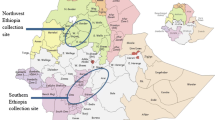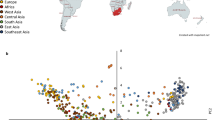Summary
Allozyme variation as detected by starch gel electrophoresis was used to assess the extent and spatial organization of genetic variation across the entire range of Glycine canescens sensu lato. Eleven enzyme systems were assayed in 116 accessions of this taxon and 102 alleles were detected at a total of 31 loci. Eighty-one percent of loci were polymorphic. Most of this variation occurred between and very little within accessions. Three major groupings were detected. These groupings (groups 1, 2, and 3) also differed with respect to mean seed size and their geographic distribution. A further ten accessions stood out from these distinct groups. These accessions were most closely related to group 3 but were variable among themselves. In general, they were collected from highly dissected terrain, often in the remote interior of the continent. A final group of 18 problematic accessions (group X), originally tentatively identified as G. canescens on morphological grounds, was shown to be isozymically distinct from this species and was reclassified as one form of the polytypic species G. clandestina.
Similar content being viewed by others
References
Allard RW, Miller RD, Kahler AL (1978) The relationship between degree of environmental heterogeneity and genetic polymorphism. In: Freyser AHJ, Woldendorf JW (eds) Structure and functioning of plant populations. North-Holland, Amsterdam, pp 49–73
Brown AHD (1978) Isozymes, plant population genetic structure, and genetic conservation. Theor Appl Genet 52:145–157
Brown AHD (1989a) Core collections: a practical approach to genetic resources management. Genome 31:818–824
Brown AHD (1989b) The case for core collections. In: Brown AHD, Frankel OH, Marshall DR, Williams JT (eds) The use of plant genetic resources. Cambridge University Press, Cambridge, pp 136–156
Brown AHD, Weir BS (1983) Measuring genetic variability. In: Tanksley SD, Orton TJ (eds) Isozymes in plant genetics and breeding, part A. Elsevier, Amsterdam, pp 219–239
Brown AHD, Grant JE, Pullen R (1986) Outcrossing and paternity in Glycine argyrea by paired fruit analysis. Biol J Linn Soc 29:283–294
Brown AHD, Grace JP, Speer SS (1987) Designation of a “core” collection of perennial Glycine. Soybean Genet Newslett 14:59–70
Brown AHD, Frankel OH, Marshall DR, Williams JT (1989) The use of plant genetic resources. Cambridge University Press, Cambridge
Burdon JJ (1986) The potential of Australian native Glycine as sources of resistance to soybean leaf rust (Phakopsora pachyrhizi). In: Nampompeth B, Subhadrabandhu S (eds) New frontiers in breeding researchers. Faculty of Agriculture, Kasetsart University, Bangkok, pp 823–832
Burdon JJ (1987) Phenotypic and genetic patterns of resistance to the pathogen Phakopsora pachyrhizi in populations of Glycine canescens. Oecologia 73:257–267
Burdon JJ (1988) Major gene resistance to Phakopsora pachyrhizi in Glycine canescens, a wild relative of soybean. Theor Appl Genet 75:923–928
Burdon JJ, Speer SS (1984) A set of differential Glycine hosts for the identification of races of Phakopsora pachyrhizi Syd. Euphytica 33:891–896
Clegg MT, Allard RW (1972) Patterns of genetic differentiation in the slender wild oat species Avena barbata. Proc Natl Acad Sci USA 69:1820–1824
Doyle JJ, Doyle JL, Brown AHD (1990) A chloroplast DNA phyllogeny of the wild perennial relatives of soybean (Glycine subgenus Glycine): congruence with morphological and crossing groups. Evolution (in press)
Doyle MJ, Brown AHD (1985) Numerical analysis of isozyme variation in Glycine tomentella. Biochem Syst Ecol 13:413–419
Grant JE, Brown AHD, Grace JP (1984) Cytological and isozyme diversity in Glycine tomentella Hayata (Leguminosae). Aust J Bot 32:665–677
Hammatt N, Nelson RS, Davey MR (1987) Plant regeneration from seedling expiants of perennial Glycine species. Plant Cell Tiss Org Cult 11:3–11
Hamrick JL, Godt MJ (1989) Allozyme diversity in plant species. In: Brown AHD, Clegg MT, Kahler AL, Weir BS (eds) Plant population genetics breeding and genentic resources. Sinauer Associates, Sunderland/MA, pp 43–63
Harlan JR (1984) Evaluation of wild relatives of crop plants. In: Holden JHW, Williams JT (eds) Crop genetic resources: conservation and evaluation. Allen and Unwin, London, pp 212–222
Hawkes JG (1977) The importance of wild germ plasm in plant breeding Euphytica 26:615–621
Hermann FJ (1962) A revision of the genus Glycine and its immediate allies. USDA Technical Bulletin No. 1268, pp 1–82
Hurka H, Freundner S, Brown AHD, Plantholt U (1989) Aspartate aminotransferase isozymes in the genus Capsella (Brassicaceae): subcellular location, gene duplication, and polymorphism. Biochem Genet 27:77–90
Newell CA, Luu HT (1985) Protoplast culture and plant regeneration in Glycine canescens F. J. Herrn. Plant Cell Tiss Org Cult 4:145–149
Newell CA, Delannay X, Edge ME (1987) Interspecific hybrids between soybean and wild perennial relatives. J Hered 78:301–306
Pichersky E, Gottlieb LD (1983) Evidence for the duplication of the structural genes coding plastid and cytosolic isozymes of triose phosphate isomerase in diploid species of Clarkia. Genetics 105:421–436
Putievsky E, Broué P (1979) Cytogenetics of hybrids among perennial species of Glycine subgenus Glycine. Aust J Bot 27:713–723
Rech EL, Golds TJ, Hammatt N, Mulligan BJ, Davey MR (1988) Agrobacterium rhizogenes-mediated transformation of the wild soybeans Glycine canescens and Glycine clandestine. Production of transgenic plants of G. Canescens. J Exp Bot 39:1275–1285
Rick CM (1973) Potential genetic resources in tomato species: clues from observations in native habitats. In: Srb AM (ed) Genes, enzymes, populations. Plenum, New York, pp 255–269
Singh RJ, Kollipara KP, Hymowitz T (1988) Further data on the genomic relationships among wild perennial species (2n = 40) of the genus Glycine Willd. Genome 30:166–176
Author information
Authors and Affiliations
Additional information
Communicated by P. M. A. Tigerstedt
Rights and permissions
About this article
Cite this article
Brown, A.H.D., Burdon, J.J. & Grace, J.P. Genetic structure of Glycine canescens, a perennial relative of soybean. Theoret. Appl. Genetics 79, 729–736 (1990). https://doi.org/10.1007/BF00224237
Received:
Accepted:
Issue Date:
DOI: https://doi.org/10.1007/BF00224237




